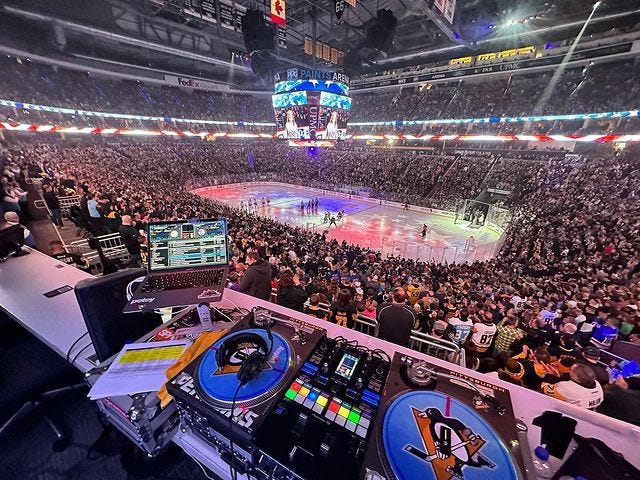Examining PWHL Potential Expansion
Where Could Women's Hockey Go Next?
Before I get to this piece, I’d like to apologize for my lack of content. I’ve had a lot going on in life lately, and I’ve had to prioritize client work and other things over writing here. While I’ve had a few people pledge to support me financially, I’m not even going to consider taking their money until I think I’m providing enough quality content. So I had to pause here, something I didn’t want to do.
Hopefully, I can be back now. I’ll try my best to be.
Anyway, something I have had time to notice is that women’s professional hockey is having a moment. The Professional Women’s Hockey League is proving to be a major success in several markets, including Ottawa, Montreal, Toronto and the Twin Cities of Minneapolis and Saint Paul. Considering there are only six teams in the league, having five healthy franchises is a great start. Only New York is struggling to gain a foothold, and that seems more because of playing in Bridgeport, Conn., than anything else. When New York went the other way and played at the Prudential Center in Newark, a decent crowd showed up.
Understandably, the league doesn’t want to expand too quickly. It’s easy to make the mistake of MLS and bring in teams far too quickly. In the early days of MLS, the league was far too quick to expand to markets that weren’t ready for teams. Miami was a perfect example: the Fusion failed within four seasons after a flying start. Today, a different Miami club is a healthy franchise, but it needed to wait until the time was right to try again. Grabbing Lionel Messi also didn’t hurt, but that’s another story.
So the PWHL can’t do too much, too soon. But they should be doing their research so they can expand when the time is right. Where should they add teams? The best places are going to be spots that both grow the league and are likely to fully embrace women’s hockey. These cities appear most likely to work.
Detroit
The game between Boston and Ottawa at Little Caesars Arena showed what can happen in Detroit. The game attracted 13,736 to set a U.S. record, and there wasn’t even a Detroit team playing. Beyond that, “Hockeytown” has always seemed like a natural fit for the PWHL for a few reasons.
One of the best is just how many girls play hockey in Michigan. According to USA Hockey, only Minnesota, Massachusetts and New York have more registered female hockey players than Michigan, and most are high school age or below. With more than 5,000 girls and women playing hockey in Michigan, there’s a natural love for the game.
That doesn’t even include Windsor, just across the lake from Detroit. A team in Detroit would certainly draw fans from Canada as well as Michigan and northwest Ohio. There’s also the fact that women’s hockey fans in Michigan have no college team to call their own. The Big Ten notably doesn’t sponsor women’s hockey because neither Michigan nor Michigan State offer the sport, while both schools are powers in men’s hockey. A professional women’s hockey team in Detroit would appeal to the entire state. Whenever expansion happens, Detroit should be at the front of the line.
Pittsburgh
Pittsburgh is a hockey city. When a few months of living in western Pennsylvania can turn my colleague John Fredericks into a hockey fan, it’s clear that hockey is part of the Steel City’s blood. Besides that, the Pittsburgh Penguins want this to happen. The Penguins envision a future where Pittsburgh’s women’s team plays at either PPG Paints Arena or the Lemieux Sports Complex. Either option would mean full backing of the Penguins, who have made no secret about their desire to be part of this league.
The PWHL’s exhibition in Pittsburgh attracted a strong crowd, and there’s no question the Penguins would market the team extensively. Western Pennsylvania doesn’t have anywhere near as many hockey players as Michigan, but it’s got a decent amount and could draw fans from eastern Ohio as well as Pennsylvania. There’s also no professional basketball in Pittsburgh, so the only competition would be the Penguins — who’d be supporting the team at every opportunity — and the local college basketball scene.
That’s a recipe for success. A team in Pittsburgh would likely be highly successful.
Philadelphia

Pittsburgh and Philadelphia have a rivalry in everything, and there would be instant spice here if both Pennsylvania cities got a PWHL team. Part of the reason for Philadelphia being a choice stems from neighbor New Jersey, which boasts over 2,000 registered female hockey players. However, most of them appear clustered toward the south of the state, which means Philadelphia would be an easier drive than New York.
Throw in another 1,800 in eastern Pennsylvania, and the love of the game is clear from the market. Philadelphia was one of the cities considered for the initial six-team launch, and reports from 2022 painted the Flyers as supportive of the PWHL’s efforts. The biggest question is the building, as the Wells Fargo Center is the only real option in Philadelphia right now. A playtest game might work there, but filling it nightly might be tough at this stage in the league’s growth.
The Philadelphia Soul of the Arena Football League might be a potential model for how a Philadelphia PWHL team could work: they plan to play their games out of Trenton’s Cure Insurance Arena, which seats 8,500 fans. That’s an ideal size for the PWHL at this stage, although playing 45 minutes from Philly is far less ideal. The market is there; solving the building is the critical piece of the puzzle.
Milwaukee or Chicago

It’s weird that Milwaukee has never gotten an NHL team to call its own. The city has a beautiful arena in the Fiserv Forum and its love for hockey is unquestioned with the success and support of the Wisconsin Badgers. With almost 5,000 women and girls playing hockey in Wisconsin, there’s no doubt that a market exists here.
It’s also weird that the Fiserv Forum doesn’t have a hockey tenant. The AHL’s Milwaukee Admirals actually play at UW-Milwaukee Panther Arena, which holds just under 11,000 compared to more than 15,000 at Fiserv Forum. That makes the building question thorny: would it be better to be the only hockey team in an NBA (and NCAA) building and potentially curtain off seats, or would it be better to play in a smaller arena that’s easier to sell out but harder to secure dates?
Minnesota makes it work at the Xcel Energy Center, and Wisconsin has enough hockey fans to try the Fiserv Forum with a PWHL squad. (Wisconsin vs. Minnesota would also be an instant rivalry.) This area needs a playtest game to see how well the league would work here.
Of course, Chicago is also a strong possibility. Illinois doesn’t have as many female hockey players as Wisconsin, but it’s double the size of Wisconsin and Chicago is massive. Ideally, someday the PWHL follows the example of both the NBA and MLB and goes to both cities. But for now, I think Milwaukee should be the choice.
Washington/Baltimore

For a smaller state, Maryland cares about women’s hockey. The Old Line State has the highest number of registered hockey players in what USA Hockey calls the Southeastern United States, boasting almost 1,500. Most of those players will cluster around the District and Baltimore, which means either city would work for an area PWHL team.
CFG Bank Arena in downtown Baltimore doesn’t have a tenant at all. It’s a little large at 14,000, but Baltimore has neither the NBA nor the NHL to compete with in the winter. Washington is closer to the market of women’s hockey players and fans in Virginia, but finding a building is harder. Capital One Arena already houses two teams and didn’t fit the WNBA’s Mystics, who now play at the Entertainment and Sports Arena. That arena doesn’t appear to have ice, so it wouldn’t work.
Like Philadelphia, the challenge here is finding the right place to put the team. Being the only tenant in Baltimore just might do the trick.
New Hampshire

There’s a reason the AHL used to have teams in Maine and New Hampshire, along with three teams in Massachusetts and another in Rhode Island. It’s because hockey works in New England. Maine, New Hampshire and Vermont all have more than 1,000 female hockey players registered in the state. A Tri-State PWHL franchise would unite all three into one fan base and really help a team thrive.
Putting the team in New Hampshire makes the most sense, as it would be the most central location between the three states. This premise is similar to the WNBA’s Connecticut Sun. The NBA would never think to go to Connecticut, but the WNBA recognized that because of the success of the Connecticut Huskies, a WNBA franchise would probably work in the state. To this day, the Sun remain a thriving franchise.
There would also be an instant rivalry with Boston. The other New England states have never had their own team to challenge Boston in anything; they’ve always had to latch on to Boston’s teams and call them their own. Creating a unique situation would give the PWHL something no other league has.



